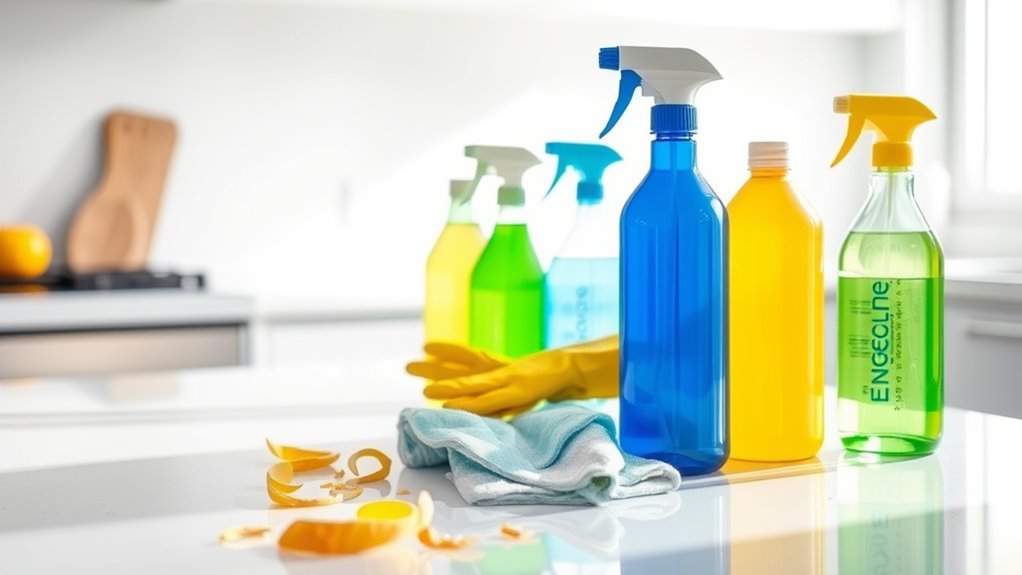How to Clean Using Enzyme-Based Cleaners
To clean with enzyme-based cleaners, first clear loose dirt and protect nearby items. Apply the cleaner evenly on organic stains like pet messes or food spills, avoiding unsealed wood. Let enzymes work by breaking down proteins and fats naturally, then wipe with a soft cloth and rinse well to remove residue. These cleaners are great on carpets, fabrics, and sealed surfaces. If you want to get the most out of them, there’s more you can explore about their use.
Understanding Enzyme-Based Cleaners

Although enzyme-based cleaners might sound complex, they’re actually quite straightforward and effective for tackling tough stains and odors. When you understand enzyme functions, you realize these cleaners break down organic matter at a molecular level, freeing you from stubborn grime without harsh chemicals. This means you get powerful cleaning benefits while keeping your space safe and fresh. Enzymes target specific substances like proteins, fats, or starches, making your cleaning more efficient and eco-friendly. You don’t have to waste time scrubbing endlessly or worry about toxic residues. Instead, you gain a simple, natural way to maintain cleanliness that lets you enjoy your freedom—free from stains, odors, and the stress of tough messes. Embracing enzyme-based cleaners is a smart, effective choice for anyone seeking effortless cleaning power.
Identifying Suitable Surfaces and Stains
When deciding where to use enzyme-based cleaners, you’ll find they’re best suited for organic stains like food, pet messes, and bodily fluids. These cleaners work wonders on stain categories that involve proteins, fats, and carbohydrates, breaking them down naturally. When it comes to surface types, enzyme cleaners are ideal for porous materials such as carpets, upholstery, and fabrics, where typical cleaners might fail to reach deep stains. They’re also safe on sealed hardwood, tile, and linoleum, but you should avoid unsealed wood or delicate surfaces that might react poorly. By understanding which stain categories and surface types respond well to enzymes, you gain freedom to clean effectively without harsh chemicals, keeping your space fresh while respecting your environment.
Preparing the Area for Cleaning

Before you start cleaning with enzyme-based cleaners, make certain the area is free of loose dirt and debris that could interfere with the cleaner’s effectiveness. Begin by clearing clutter to give yourself unrestricted access to the surfaces you’re treating. This not only makes your job easier but also prevents any accidental damage or spills on items nearby. Next, focus on protecting surfaces that might be sensitive to moisture or cleaner exposure, like wood or electronics. Lay down towels or plastic sheets to guard these areas, so you can clean freely without worry. Taking these simple steps guarantees the enzyme cleaner can work directly on the stains and grime, maximizing its natural power while giving you the freedom to clean confidently and efficiently.
Applying the Enzyme Cleaner Correctly
Since enzyme-based cleaners rely on direct contact with stains, you’ll want to apply them thoroughly and evenly. Start by choosing the right application techniques—spraying works great for large surfaces, while dabbing can target stubborn spots. Make certain the product concentration matches your stain’s severity; stronger concentrations handle tougher messes, but don’t overdo it where lighter cleaning is needed. You want the enzymes to work efficiently without wasting product. Apply enough cleaner to saturate the area but avoid flooding it, as excess liquid can cause issues or slow the cleaning process. Remember, even coverage guarantees enzymes reach all parts of the stain for maximum effect. By mastering these application techniques and respecting product concentration, you’ll enjoy a cleaner space without unnecessary hassle or waste.
Allowing Time for Enzyme Action

Once you’ve applied the enzyme cleaner, you’ll need to give it time to work effectively. The ideal activation time can vary depending on factors like temperature and the type of stain. Watch for signs that the stain has fully broken down before wiping or rinsing.
Optimal Enzyme Activation Time
While enzyme-based cleaners start working as soon as you apply them, giving them enough time to activate is essential for the best results. To harness the full power of these cleaners, understanding ideal enzyme timing is key. You’ll want to let the enzymes sit undisturbed for at least 10 to 15 minutes, depending on the stain and surface. This pause allows the enzymes to break down organic matter efficiently. Quick wiping or rinsing can interrupt enzyme activation methods, reducing effectiveness. So, resist the urge to rush the process—you’re giving the enzymes the freedom they need to work their magic. By respecting this ideal activation time, you’ll achieve deeper, more thorough cleaning without extra effort. Patience here really frees you from stubborn messes.
Factors Affecting Enzyme Efficiency
Understanding what affects enzyme efficiency is essential for getting the best results from your cleaner. Enzymes work best within specific temperature ranges and pH balances; straying too far can slow them down or deactivate them. Allowing enough time for enzyme action lets these tiny powerhouses break down stains thoroughly. Here’s a quick guide to factors influencing enzyme efficiency:
| Factor | Ideal Range | Effect if Out of Range |
|---|---|---|
| Temperature | 30°C – 50°C | Reduced activity or denaturation |
| pH Balance | 6.5 – 8.0 | Enzyme structure distortion |
| Contact Time | 10 – 30 minutes | Incomplete stain breakdown |
Keep these in mind, and you’ll liberate your cleaning routine for truly effective results.
Signs of Complete Breakdown
Giving enzymes enough time to work is just as important as keeping them within the right temperature and pH range. When you allow enzyme activity to fully progress, you’ll notice clear breakdown indicators: stubborn stains start fading, unpleasant odors vanish, and residue loosens effortlessly. These signs tell you the enzymes have completely broken down organic matter, freeing your space from grime without harsh chemicals. Rushing the process often means incomplete cleaning and wasted product—so embrace the patience that enzyme cleaners require. By respecting this natural timeline, you’re harnessing the full power of enzymes, achieving a deeper, more effective clean that supports your desire for a free, chemical-light lifestyle. Keep an eye out for those breakdown indicators to know when the job’s truly done.
Wiping and Rinsing Surfaces
After applying the enzyme-based cleaner, you’ll want to wipe down the surface thoroughly to break down residues effectively. Using the right cleaning techniques is key—choose a soft cloth or sponge to avoid damaging delicate surface materials like wood or glass. Wiping helps lift away loosened grime and lets the enzymes work deeper. Once wiped, rinse the surface with clean water to remove any remaining cleaner and waste, preventing buildup. Rinsing also refreshes the surface, leaving it ready for use without harsh chemical residues. Remember, adapting your approach based on the surface materials guarantees you maintain their integrity while enjoying the freedom of a truly clean space. With these steps, you control your environment easily and naturally.
Storing Enzyme Cleaners Safely
Once you’ve finished cleaning and rinsing surfaces, it’s important to store your enzyme-based cleaners properly to keep them effective for future use. Proper storage means keeping the cleaner in a cool, dry place away from direct sunlight and extreme temperatures, which can degrade the enzymes. Make certain the container is tightly sealed to prevent contamination and evaporation. For safe handling, always keep these cleaners out of reach of children and pets, and label the bottles clearly to avoid accidental misuse. Storing them in a dedicated cabinet or shelf guarantees you maintain control over your cleaning supplies without clutter. By following these straightforward steps, you’ll extend the life of your enzyme cleaners and stay free from worries about spills or accidents. Safe storage gives you freedom to clean confidently anytime.
Frequently Asked Questions
Can Enzyme Cleaners Be Used in Septic Systems Safely?
Imagine your septic system as a delicate ecosystem, like a garden needing balance. You can safely use enzyme cleaners because they support septic tank maintenance by promoting enzyme breakdown of organic waste, keeping things flowing smoothly. Just like a gardener trusts natural compost to nourish plants, you can trust enzymes to help your system without harsh chemicals. This means you can maintain your freedom from clogs and costly repairs while keeping your septic system healthy.
Are Enzyme Cleaners Effective Against Mold and Mildew?
You’ll find enzyme cleaners pretty effective for mold removal since they break down organic matter mold feeds on. They’re great if you want a natural way to tackle mold without harsh chemicals. Plus, they help with mildew prevention by stopping regrowth at the source. Using them lets you keep your space fresh and safe, giving you freedom from stubborn mold and mildew without sacrificing your health or the environment.
How Do Enzyme Cleaners Compare to Bleach in Disinfecting?
When comparing enzyme effectiveness to bleach safety, you’ll find enzyme cleaners break down organic matter gently, making them great for ongoing cleaning without harsh fumes. Bleach, while powerful at disinfecting, can be risky if misused, releasing strong chemicals that limit your freedom to use it anywhere. If you want a safer, eco-friendly option that still tackles germs, enzymes offer a more natural, less restrictive way to keep your space clean.
Can Enzyme Cleaners Cause Allergic Reactions in Sensitive Individuals?
Imagine stepping out of a medieval castle into modern freedom—just like that, enzyme cleaners can bring freshness without harsh chemicals. However, if you’ve got sensitive skin, you should know that enzyme cleaners can sometimes cause allergic reactions, especially if you’re prone to allergies. Don’t let that hold you back; test a small area first. Stay free to enjoy a cleaner space while protecting your skin’s delicate balance.
Do Enzyme Cleaners Have an Expiration Date or Shelf Life?
Yes, enzyme cleaners do have an expiration date because their shelf stability depends on storage conditions. If you keep them sealed and stored in a cool, dry place, they’ll last longer and stay effective. But if they’re exposed to heat or moisture, their enzymes can break down faster. To enjoy your freedom from harsh chemicals, just check the label for the shelf life and store your cleaner properly to get the best results.






